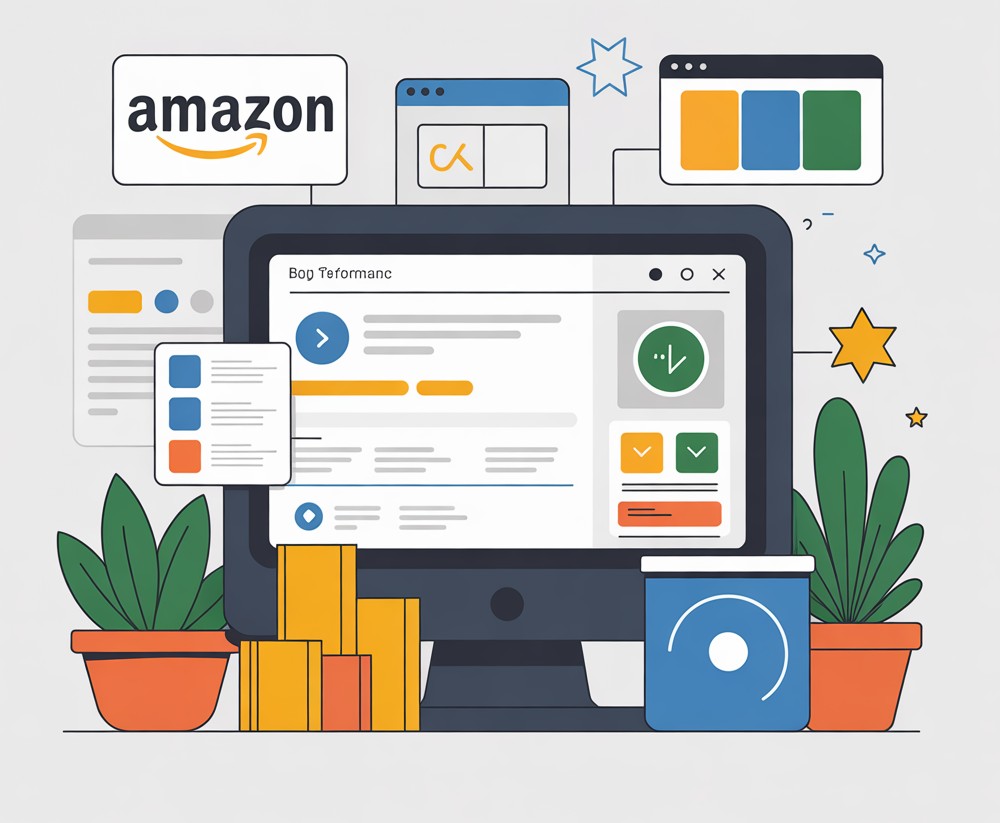If your product is well-optimized but still struggling to gain traction, you’re not alone. With millions of sellers competing in the marketplace, even the best listings need a push to get noticed — that’s where Amazon PPC (Pay-Per-Click) advertising comes in.
Amazon PPC helps sellers place their products directly in front of high-intent buyers. When done strategically, it not only increases sales but also boosts your organic ranking, creating a long-term compounding effect.
This guide will walk you through everything you need to know — from setup to optimization — so you can start driving profitable results from your campaigns.
What Is Amazon PPC Advertising?
Amazon PPC (Pay-Per-Click) is an auction-based advertising system where you pay only when a shopper clicks your ad.
Your ads appear in prominent positions like:
- Top of search results
- Product detail pages
- Sponsored listings and related products
Amazon PPC is crucial for:
- Launching new products
- Increasing visibility in competitive categories
- Boosting organic ranking through sales velocity
- Targeting specific audiences and keywords
Types of Amazon PPC Ads
Amazon offers three main types of ad campaigns. Understanding them helps you design the right strategy for your goals.
1. Sponsored Products
- The most common and effective ad type.
- Ads appear within search results or on product pages.
- Based on keyword targeting (manual or automatic).
Best for: driving direct product sales.
2. Sponsored Brands
- Showcases your brand logo, a custom headline, and multiple products.
- Appears at the top of search results — great for brand awareness.
Best for: promoting your brand identity and multiple SKUs.
3. Sponsored Display
- Reaches audiences both on and off Amazon.
- Uses AI to target users based on their behavior (e.g., viewed similar products).
Best for: retargeting or re-engaging customers who didn’t purchase.
How Amazon PPC Works
When you launch an ad campaign, you choose:
- Keywords or product targets
- Bids (how much you’re willing to pay per click)
- Daily budget
Amazon’s system runs an auction. If your bid and relevance are strong, your ad appears — and you pay only when someone clicks it.
Formula:
Ad Placement = Bid Amount × Relevance Score
That means better-optimized listings and relevant targeting can win top ad positions — even with lower bids.
Understanding Key Amazon PPC Metrics
To manage your campaigns effectively, you must understand the core metrics:
| Metric | Meaning | Ideal Range |
|---|---|---|
| Impressions | How many times your ad was seen | Higher is better |
| CTR (Click-Through Rate) | % of viewers who clicked | 0.3% – 0.5%+ |
| CPC (Cost Per Click) | Average cost per ad click | As low as possible |
| ACOS (Advertising Cost of Sale) | Ad Spend ÷ Ad Revenue × 100 | 15%–30% for profitability |
| ROAS (Return on Ad Spend) | Revenue ÷ Ad Spend | 3×–5× ideal |
| Conversion Rate | % of clicks that led to sales | 8%–15% typical |
Monitoring these metrics weekly helps identify wasted spend and scaling opportunities.
Setting Up Your First PPC Campaign
Follow this simple step-by-step guide:
- Log in to Seller Central → Click “Advertising” → “Campaign Manager”.
- Choose Campaign Type (Start with Sponsored Products).
- Set Daily Budget (Start small — $10–$20/day).
- Select Targeting Type:
- Automatic Targeting: Amazon picks keywords for you (good for beginners).
- Manual Targeting: You select keywords based on research (for experienced sellers).
- Add Keywords:
- Broad Match (flexible)
- Phrase Match (semi-targeted)
- Exact Match (specific)
- Set Bids – Start slightly below suggested bids to test performance.
- Launch Campaign and monitor daily.
Optimization Tips for Amazon PPC
1. Start with Auto Campaigns
Use an Automatic Campaign first to discover converting search terms. After 7–10 days, download the Search Term Report and analyze:
- Which keywords convert
- Which have high spend but no sales
Move converting keywords to Manual Campaigns and add poor performers as Negative Keywords.
2. Use Manual Campaigns for Control
Manual campaigns allow you to:
- Set custom bids per keyword
- Target high-intent search terms
- Eliminate waste on irrelevant clicks
Segment your campaigns:
- Top keywords (Exact Match)
- Related keywords (Phrase Match)
- Exploratory terms (Broad Match)
3. Focus on ACOS and Profitability
Calculate your break-even ACOS (based on profit margin).
Example:
If your product’s profit margin is 25%, your ACOS should stay below 25% to stay profitable.
Use tools like Helium 10 Adtomic or SellerApp to monitor performance efficiently.
4. Optimize Product Listings
Your ad is only as good as your listing. Ensure your:
- Product title and bullets are keyword-optimized
- Images are high-quality and zoomable
- Reviews and ratings are 4+ stars
This increases conversion rate and improves your ad ranking automatically.
5. Retarget with Sponsored Display
Once your campaigns are stable, expand using Sponsored Display Ads to re-engage shoppers who:
- Viewed your product but didn’t buy
- Bought similar items from competitors
These ads can significantly increase your ROI.
Common PPC Mistakes to Avoid
- Running campaigns without analyzing reports
- Not adding negative keywords — wastes budget
- Ignoring product optimization
- Using one campaign for all products — reduces clarity
- Setting and forgetting — PPC needs weekly tuning
Conclusion
Amazon PPC is a powerful engine for driving visibility, sales, and organic ranking — but it’s not a “set it and forget it” tool. Success comes from continuous testing, data-based optimization, and clear targeting.
Start small, analyze results weekly, and scale what works. Over time, you’ll transform your ad spend into a steady stream of profitable sales.


